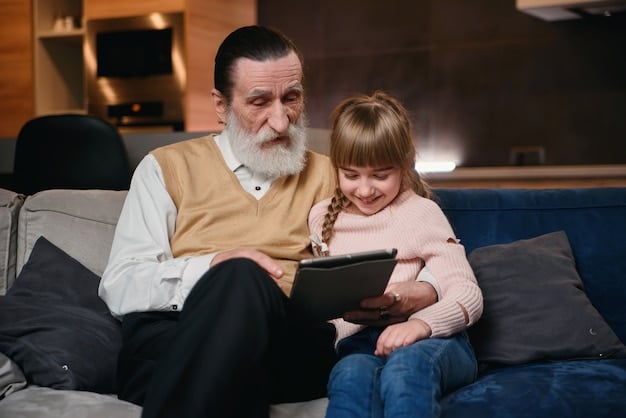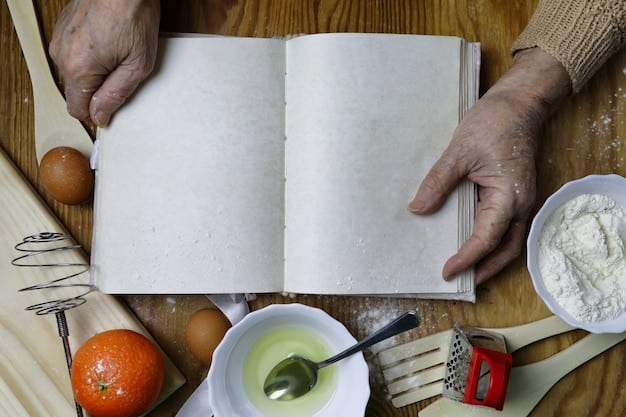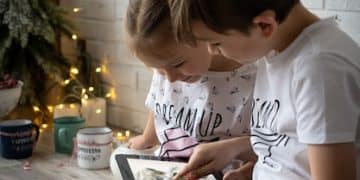Family History Project: 3 Ways to Explore Your Ancestry Together (2025)

Embark on a fascinating Family History Project in 2025 by exploring your ancestry together through interactive storytelling, digital archiving, and creating a family heritage cookbook, fostering connection and preserving your unique legacy for future generations.
Dive into the captivating world of your family’s past with a **Family History Project: 3 Ways to Explore Your Ancestry Together (Discover Your Roots in 2025)**. This engaging activity promises to strengthen family bonds while unveiling the stories and traditions that have shaped your identity.
Uncover Your Family’s Narrative Through Interactive Storytelling
Begin your family history adventure by transforming genealogy into an engaging narrative. Interactive storytelling breathes life into dates and names, making the past relevant and exciting for all family members. This approach can turn a simple research project into a cherished shared experience.
Imagine gathering around a table, not just to share a meal, but to share stories. Older family members can recount their memories while younger generations listen, ask questions, and document the details. These stories, often passed down orally, hold invaluable pieces of your heritage.
Preserving Oral Histories
Oral histories are a treasure trove of personal anecdotes and cultural insights that might not be found in written records. Encourage family elders to share their experiences, which can range from everyday life to significant historical events.
Creating a Storytelling Prompt List
To stimulate memories and structure your storytelling sessions, prepare a list of prompts. These can be general questions about childhood, work, or family traditions, or more specific inquiries about ancestors and their lives.
* What are some of your earliest childhood memories?
* Can you describe a typical holiday celebration when you were growing up?
* What kind of work did our ancestors do?
* What challenges did they face, and how did they overcome them?
Documenting Your Family’s Stories
As your family shares their stories, document them meticulously. Record the conversations using audio or video equipment, and take detailed notes. These recordings and notes will form the basis of your family history narrative.
Interactive storytelling offers a dynamic way to engage with your family’s past, foster intergenerational connections, and create a lasting legacy of cherished memories. By actively involving all family members in the storytelling process, you transform a simple history lesson into an unforgettable bonding experience.

Build a Digital Archive to Preserve Family Memories
Creating a digital archive is essential for preserving family memories and making them accessible to future generations. In the digital age, physical documents and photographs can deteriorate or become lost over time. A well-organized digital archive ensures that your family history remains intact and easily shareable.
The first step in building a digital archive is to gather all relevant materials. This includes photographs, letters, journals, official documents (such as birth certificates and marriage licenses), and any other items that offer insights into your family’s past.
Scanning and Digitizing Physical Materials
Carefully scan or photograph each item to create digital copies. Use high-resolution settings to capture as much detail as possible. For delicate documents, consider using a flatbed scanner to avoid damage.
Organizing Digital Files
Develop a clear and consistent organizational system for your digital files. Create folders and subfolders based on family names, dates, or events. Use descriptive file names to make it easy to locate specific items.
Choosing a Storage Solution
Select a reliable storage solution to house your digital archive. Options include cloud storage services (such as Google Drive, Dropbox, or iCloud), external hard drives, or a combination of both. Cloud storage provides the advantage of accessibility from anywhere, while external hard drives offer a secure, offline backup.
* Cloud Storage Services: Convenient and accessible, but consider subscription costs and privacy implications
* External Hard Drives: Secure and offline, but vulnerable to physical damage or loss
* Combination: Best of both worlds, with cloud storage for easy access and external hard drives for backup
Sharing Your Digital Archive
Once your digital archive is complete, consider sharing it with family members. You can create a private online portal or share access to a cloud storage folder. Ensure that everyone understands how to navigate the archive and contribute additional materials.
Building a digital archive is a powerful way to safeguard your family history and make it accessible for generations to come. By carefully digitizing, organizing, and storing your family’s memories, you create a lasting legacy that can be cherished and shared for years to come.
Craft a Family Heritage Cookbook Filled With Treasured Recipes
A family heritage cookbook is more than just a collection of recipes; it’s a culinary chronicle of your family’s history, traditions, and cultural identity. It preserves cherished recipes and the stories behind them, making it a meaningful project that connects generations through the universal language of food.
Start by gathering recipes from family members. Ask everyone to contribute their favorite dishes, traditional meals, and special occasion recipes. Include handwritten recipes, even if they are faded or incomplete, as they add a personal touch to the cookbook.
Collecting Recipes and Stories
Each recipe should be accompanied by a story or anecdote. Where did the recipe originate? Who made it most often? What memories are associated with the dish? These stories transform simple recipes into meaningful narratives.
Organizing Your Cookbook
Organize your cookbook in a way that makes sense for your family. You can categorize recipes by type (appetizers, main courses, desserts), by family member (Grandma’s famous apple pie), or by cultural origin (Italian pasta dishes).
Designing Your Cookbook
Consider the visual appeal of your cookbook. Include photographs of family members cooking or enjoying the dishes. Use a consistent layout and font to create a polished and professional look.
* Photographs: Add visual interest and personal connection
* Layout: Ensure readability and easy navigation
* Font: Choose a font that is both legible and aesthetically pleasing
Publishing and Sharing Your Cookbook
Once your cookbook is complete, consider publishing it. You can print copies for family members or create a digital version that can be shared online. There are also online services that allow you to design and print professional-quality cookbooks.
Creating a family heritage cookbook is a unique and engaging way to celebrate your family’s history and traditions. By preserving treasured recipes and the stories behind them, you create a culinary legacy that can be enjoyed and passed down for generations to come. It’s a delicious way to connect with your past and strengthen family bonds.

Document Family Traditions And Cultural Practices
Delving into family traditions and cultural practices offers a profound understanding of your heritage. These practices, passed down through generations, shape your family’s identity and connect you to a broader cultural history. Documenting these traditions ensures they are preserved and cherished.
Begin by identifying the traditions and practices that are unique to your family. These can range from holiday celebrations to daily routines, from religious customs to unique family rituals. Consider the cultural origins of these practices and how they have evolved over time.
Interviewing Family Members
Conduct interviews with family members to gather information about these traditions. Ask about the origins of each practice, how it is typically observed, and what it means to them personally.
Creating a Family Tradition Timeline
Develop a timeline that traces the evolution of your family traditions. This timeline can highlight key moments in your family’s history and illustrate how cultural practices have been adapted or modified over time.
Preserving Artifacts and Memorabilia
Collect artifacts and memorabilia associated with your family traditions. These can include photographs, clothing, religious items, or any other objects that hold significance.
* Photographs: Capture visual representations of family traditions
* Clothing: Preserve garments worn during special occasions
* Religious Items: Document spiritual practices and beliefs
Sharing Your Findings
Share your findings with family members through presentations, newsletters, or online platforms. This creates a shared understanding of your family’s history and encourages continued participation in these meaningful traditions.
Documenting family traditions and cultural practices is a vital part of any family history project. By preserving these unique aspects of your heritage, you ensure that they continue to enrich your family’s identity and connect you to a broader cultural narrative.
Discovering Genealogical Records and Historical Documents
Genealogical records and historical documents are the cornerstones of any thorough family history project. These records provide concrete evidence of your ancestors’ lives, allowing you to piece together their stories and understand their place in history. Exploring these resources can uncover fascinating details about your family’s past.
Start by identifying the key genealogical resources available to you. These include census records, birth certificates, marriage licenses, death certificates, immigration records, military records, and land records. Each type of record offers unique insights into your ancestors’ lives.
Accessing Online Databases
Many genealogical records are now available online through databases like Ancestry.com, FamilySearch, and MyHeritage. These databases allow you to search for specific ancestors and view digitized images of historical documents.
Visiting Local Archives and Libraries
If you prefer a more hands-on approach, visit local archives and libraries in the areas where your ancestors lived. These institutions often hold original documents and records that are not available online.
Analyzing Historical Documents
When you locate historical documents, take the time to analyze them carefully. Pay attention to details such as names, dates, locations, and occupations. These details can provide valuable clues about your ancestors’ lives.
* Names: Verify spellings and identify variations
* Dates: Establish timelines and key life events
* Locations: Trace your ancestors’ movements and settlements
Collaborating With Other Researchers
Consider collaborating with other researchers who may have information about your family. Genealogical societies and online forums can connect you with distant relatives or experts who can provide valuable insights.
Discovering genealogical records and historical documents is a crucial step in piecing together your family’s history. By carefully exploring these resources, you can uncover a wealth of information about your ancestors’ lives and gain a deeper understanding of your heritage.
Utilize DNA Testing To Uncover Ethnic Origins and Connections
DNA testing has revolutionized family history research, offering a powerful tool to uncover ethnic origins and connect with distant relatives. By analyzing your DNA, you can gain insights into your ancestry that might not be revealed through traditional genealogical research.
Several DNA testing companies offer services tailored to family history research. Popular options include AncestryDNA, 23andMe, and MyHeritage DNA. Each company provides a different type of analysis and a unique set of features.
Understanding DNA Testing Options
Learn about the types of DNA tests available and how they can benefit your family history project. Autosomal DNA tests, for example, provide insights into your ethnic origins and can connect you with living relatives.
Collecting Your DNA Sample
Follow the instructions provided by the DNA testing company to collect your DNA sample. Typically, this involves spitting into a tube or swabbing your cheek. Mail the sample back to the company for analysis.
Analyzing Your DNA Results
Once your DNA results are available, take the time to analyze them carefully. Review your ethnicity estimate and explore the list of DNA matches. Contact potential relatives to learn more about your shared ancestry.
* Ethnicity Estimate: Provides a breakdown of your ethnic origins
* DNA Matches: Connects you with living relatives who share your DNA
* Shared Ancestry: Explore common ancestors and family lines
Protecting Your Privacy
Be mindful of privacy concerns when sharing your DNA results. Understand the company’s privacy policies and consider limiting the amount of personal information you share with others.
Utilizing DNA testing is a valuable tool for expanding your family history research and uncovering new insights into your ancestry. By carefully analyzing your DNA results and connecting with distant relatives, you can deepen your understanding of your family’s past and build a stronger connection to your heritage.
| Key Point | Brief Description |
|---|---|
| 🗣️ Interactive Storytelling | Record stories from elders to preserve oral histories. |
| 📸 Digital Archive | Digitize photos and documents for lasting preservation. |
| 🍲 Heritage Cookbook | Compile family recipes and the stories behind them. |
| 🧬 DNA Testing | Discover ethnic origins and connect with relatives. |
Frequently Asked Questions
▼
A family history project involves researching and documenting your family’s past, including ancestors, traditions, and cultural practices, to create a comprehensive record for future generations.
▼
Start by gathering information from family members, collecting documents and photos, and exploring online genealogical resources. Begin with what you know and gradually expand your research.
▼
Useful records include census data, birth certificates, marriage licenses, death certificates, immigration records, military records, and land records, all of which provide valuable information about your ancestors.
▼
Yes, DNA testing can reveal ethnic origins and connect you with distant relatives, providing insights that traditional genealogical research may not uncover, enhancing your overall family history project.
▼
Preserve your findings by creating a digital archive, writing a family history narrative, compiling a family heritage cookbook, and sharing your research with family members to ensure it lasts for generations.
Conclusion
Undertaking a **family history project** is a rewarding endeavor that allows you to connect with your roots, preserve your family’s legacy, and strengthen bonds with loved ones. Whether you choose to focus on interactive storytelling, digital archiving, or creating a heritage cookbook, the journey of discovering your ancestry will undoubtedly enrich your life.





